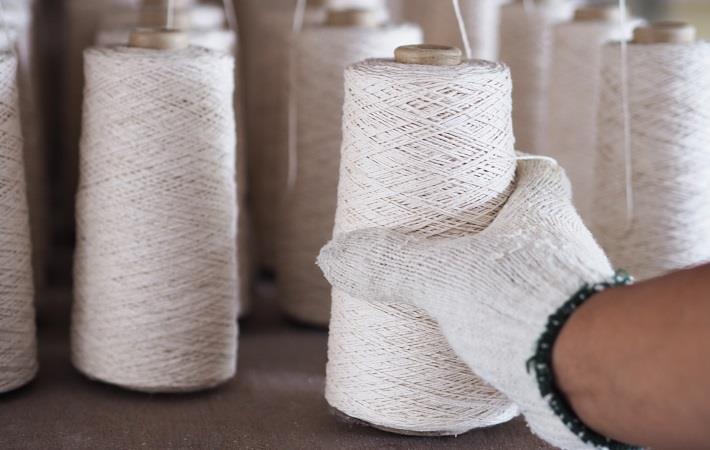Interviews
Next 2 quarters challenging for Indian cotton yarn sector
09 May '20
5 min read

Pic: Shutterstock
The anticipated benefit from lower fibre prices by the Indian cotton spinning industry is now expected to be more than offset by the challenges due to the COVID-19 outbreak, according to CARE Ratings, which said the cotton yarn industry is staring at extremely challenging next two quarters with shutdown of manufacturing units and weak downstream demand.
COVID-19 is expected to lead to a drop in revenue along with moderation in profitability margins and debt coverage indicators apart from impacting the liquidity profiles of most of the companies engaged in the sector.
Smaller companies with high debt level, limited access to bank funding and limited liquidity buffer are expected to be affected more, compared with their larger counterparts, the rating agency said in a press release.
For the last few years, Indian cotton yarn spinners have been jostling with various headwinds, including subdued export and domestic demand coupled with fluctuating cotton fibre prices. Cotton yarn exports over the last few years have taken a hit, mainly on account of subdued demand from China (largest contributor to India’s cotton yarn export).
After more than doubling in fiscal 2012-13 (in volume terms) and increasing by more than 50 per cent in the subsequent year (on a higher base), the yearly shipments to China in 2016-17 slumped by more than 25 per cent from the 2013-14 level. Though exports to China increased by around 47 per cent in 2018-19 over 2017-18, it declined significantly by 43 per cent in first ten months of fiscal 2019-20 on a year-on-year basis.
China’s major cotton yarn demand is now being catered to by Vietnam which enjoys duty-free access to China. In the last few years, Chinese companies have invested heavily in Vietnam to expand their spinning capacities leveraging low labour cost there along with favourable trade agreements.
In 2019, China also allowed Pakistan to supply 350,000 tonnes of yarn at nil rate of duty, while Indian cotton yarn, on the other hand, attracts a duty of 3.5 per cent in China making Indian cotton yarn less competitive in the Chinese market.
In the first ten months of fiscal 2019-20, India’s average monthly exports of cotton yarn stood at ₹1,616 crore, significantly lower than the monthly average of ₹2,278 crore, witnessed in the same period last year. Indian cotton fibre prices remained firm, especially in the first quarter of 2019-20, contrary to the international cotton prices, which made domestic cotton yarn spinners less attractive in the export market.
In addition to lower exports, demand of cotton yarn from the domestic apparel industry has also remained muted in the recent past. After witnessing a decline in two consecutive years (2017-18 and 2018-19), apparel exports remained almost flat (marginal increase of 0.2 per cent) in In the first ten months of fiscal 2019-20 compared with the same period in the previous fiscal. Domestic demand for apparels has also remained subdued during this period.
Lower exports and muted domestic demand has resulted in an oversupply situation in the domestic market resulting in lower realizations for cotton yarn.
Operating income for the sample of leading companies (listed on Indian stock exchanges) in the industry increased by 11 per cent in 2018-19 compared with 2017-18 figures on the back of increased export demand. However, it remained flat in the first nine months of fiscal 2019-20 on a year-on-year basis.
The Cotton Association of India (CAI) has projected a record cotton crop of 354.5 lakh bales for cotton season (CS) 2020, which is around 14 per cent higher than the last season crop of 312 lakh bales. In anticipation of higher output, and in-line with the international cotton prices, domestic cotton prices also started correcting in the second quarter of fiscal 2019-20.
Average prices of Shankar-6 variety remained around 9 per cent lower in the July 2019 to February 2020 period compared with the same period last year. However, owing to subdued demand, yarn prices have also started correcting, leading to diminishing spreads.
Owing to the Covid-19 pandemic, the demand for cotton yarn is expected to decline significantly in the firt two quarters of this fiscal, leading to deterioration in the operational and financial performance of the companies engaged in the segment. Cotton yarn prices, which were already under pressure in the last fiscal, are expected to decline further this fiscal.
With yarn realization expected to decline, and majority of the procurement cost already fixed, the spread and profitability margins of the industry players are expected to witness a further deterioration. Also, with declining cotton prices, domestic spinners could be looking at inventory losses in the future.
With major procurement of cotton almost done, majority players will be having limited cushion available in their working capital borrowings. Delay in payment from customers has also increased their reliance on the external borrowings.
CARE Ratings does not expect any major capacity increase in the industry in the next one year, with only a few large integrated players expected to undertake some capacity expansion. However, with declining profitability and increased working capital borrowings, the rating agency expects debt coverage indicators of the companies in the industry to remain under pressure at least in the next two quarters.
COVID-19 is expected to lead to a drop in revenue along with moderation in profitability margins and debt coverage indicators apart from impacting the liquidity profiles of most of the companies engaged in the sector.
Smaller companies with high debt level, limited access to bank funding and limited liquidity buffer are expected to be affected more, compared with their larger counterparts, the rating agency said in a press release.
For the last few years, Indian cotton yarn spinners have been jostling with various headwinds, including subdued export and domestic demand coupled with fluctuating cotton fibre prices. Cotton yarn exports over the last few years have taken a hit, mainly on account of subdued demand from China (largest contributor to India’s cotton yarn export).
After more than doubling in fiscal 2012-13 (in volume terms) and increasing by more than 50 per cent in the subsequent year (on a higher base), the yearly shipments to China in 2016-17 slumped by more than 25 per cent from the 2013-14 level. Though exports to China increased by around 47 per cent in 2018-19 over 2017-18, it declined significantly by 43 per cent in first ten months of fiscal 2019-20 on a year-on-year basis.
China’s major cotton yarn demand is now being catered to by Vietnam which enjoys duty-free access to China. In the last few years, Chinese companies have invested heavily in Vietnam to expand their spinning capacities leveraging low labour cost there along with favourable trade agreements.
In 2019, China also allowed Pakistan to supply 350,000 tonnes of yarn at nil rate of duty, while Indian cotton yarn, on the other hand, attracts a duty of 3.5 per cent in China making Indian cotton yarn less competitive in the Chinese market.
In the first ten months of fiscal 2019-20, India’s average monthly exports of cotton yarn stood at ₹1,616 crore, significantly lower than the monthly average of ₹2,278 crore, witnessed in the same period last year. Indian cotton fibre prices remained firm, especially in the first quarter of 2019-20, contrary to the international cotton prices, which made domestic cotton yarn spinners less attractive in the export market.
In addition to lower exports, demand of cotton yarn from the domestic apparel industry has also remained muted in the recent past. After witnessing a decline in two consecutive years (2017-18 and 2018-19), apparel exports remained almost flat (marginal increase of 0.2 per cent) in In the first ten months of fiscal 2019-20 compared with the same period in the previous fiscal. Domestic demand for apparels has also remained subdued during this period.
Lower exports and muted domestic demand has resulted in an oversupply situation in the domestic market resulting in lower realizations for cotton yarn.
Operating income for the sample of leading companies (listed on Indian stock exchanges) in the industry increased by 11 per cent in 2018-19 compared with 2017-18 figures on the back of increased export demand. However, it remained flat in the first nine months of fiscal 2019-20 on a year-on-year basis.
The Cotton Association of India (CAI) has projected a record cotton crop of 354.5 lakh bales for cotton season (CS) 2020, which is around 14 per cent higher than the last season crop of 312 lakh bales. In anticipation of higher output, and in-line with the international cotton prices, domestic cotton prices also started correcting in the second quarter of fiscal 2019-20.
Average prices of Shankar-6 variety remained around 9 per cent lower in the July 2019 to February 2020 period compared with the same period last year. However, owing to subdued demand, yarn prices have also started correcting, leading to diminishing spreads.
Owing to the Covid-19 pandemic, the demand for cotton yarn is expected to decline significantly in the firt two quarters of this fiscal, leading to deterioration in the operational and financial performance of the companies engaged in the segment. Cotton yarn prices, which were already under pressure in the last fiscal, are expected to decline further this fiscal.
With yarn realization expected to decline, and majority of the procurement cost already fixed, the spread and profitability margins of the industry players are expected to witness a further deterioration. Also, with declining cotton prices, domestic spinners could be looking at inventory losses in the future.
With major procurement of cotton almost done, majority players will be having limited cushion available in their working capital borrowings. Delay in payment from customers has also increased their reliance on the external borrowings.
CARE Ratings does not expect any major capacity increase in the industry in the next one year, with only a few large integrated players expected to undertake some capacity expansion. However, with declining profitability and increased working capital borrowings, the rating agency expects debt coverage indicators of the companies in the industry to remain under pressure at least in the next two quarters.
Fibre2Fashion News Desk (DS)
Popular News
Leave your Comments
Editor’s Pick
































-Ltd..jpg?tr=w-120,h-60,c-at_max,cm-pad_resize,bg-ffffff)





.jpg?tr=w-120,h-60,c-at_max,cm-pad_resize,bg-ffffff)
.jpg?tr=w-120,h-60,c-at_max,cm-pad_resize,bg-ffffff)






